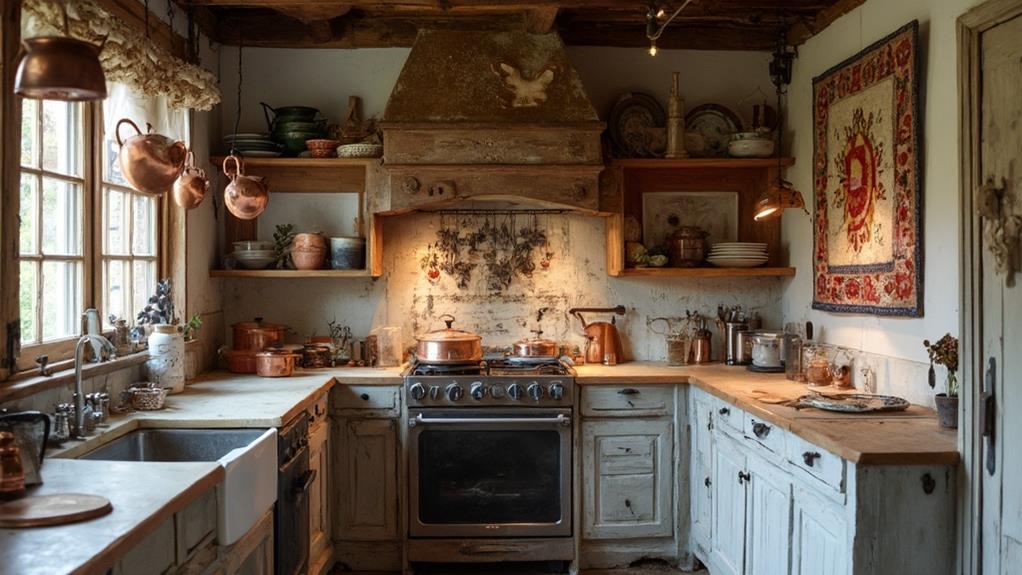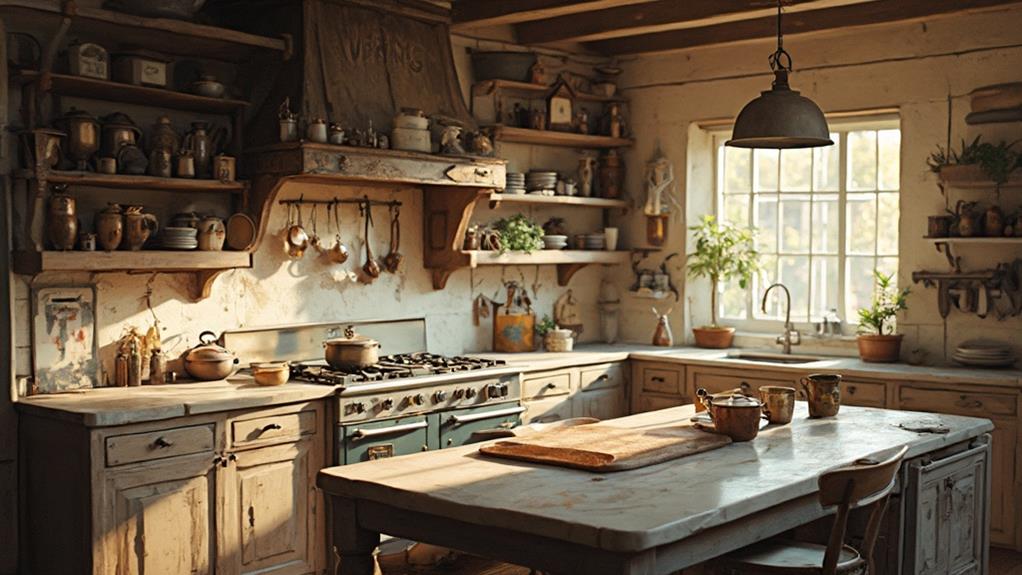To incorporate antique or heirloom pieces into your kitchen design, start by selecting items that blend functionality and aesthetic appeal. Mix old and new styles by distributing antique pieces evenly and using a unifying color palette. Display heirloom china collections in glass-front cabinets or open shelving for protection and visibility. Get creative by repurposing vintage kitchen tools, like turning a wooden rolling pin into a paper towel holder. Balance functionality with aesthetics by choosing antique pieces that serve a practical purpose and prioritizing workflow. Remember to select a few statement pieces to avoid overcrowding. With these tips, you'll create a kitchen that's both charming and functional.
Choosing the Right Antique Pieces

When picking out antique pieces for your kitchen, zero in on items that blend functionality with aesthetic appeal. Look for sturdy, well-made pieces that can withstand daily use while adding character to your space. Consider antique cabinets, hutches, or sideboards that offer storage solutions and showcase your heirloom dishes or cookware.
Don't overlook smaller items like vintage utensils, cast iron cookware, or ceramic crocks that can serve both decorative and practical purposes. Antique lighting fixtures, such as pendant lights or chandeliers, can become striking focal points while illuminating your workspace.
When selecting pieces, pay attention to their condition and potential for restoration. Opt for items that complement your kitchen's overall style, whether it's rustic farmhouse or sleek modern. Mix and match different eras to create a unique, eclectic look, but maintain a cohesive color palette to tie everything together.
Remember that antiques don't have to be confined to their original purpose. Get creative by repurposing old dressers as kitchen islands or transforming vintage ladders into pot racks. By choosing the right antique pieces, you'll infuse your kitchen with history and personality while enhancing its functionality.
Mixing Old and New Styles
Three key principles guide the successful blending of old and new styles in your kitchen: balance, contrast, and cohesion. To achieve balance, distribute antique pieces evenly throughout the space, ensuring they don't overwhelm modern elements. For example, pair a vintage farmhouse sink with sleek, contemporary faucets.
Contrast creates visual interest and highlights the unique qualities of both old and new. Consider juxtaposing a rustic wooden hutch against glossy, minimalist cabinetry. This approach draws attention to the antique's intricate details while emphasizing the clean lines of modern design.
Cohesion ties everything together, preventing a disjointed look. Choose a unifying color palette or recurring material to bridge the gap between eras. You might use brass hardware on both antique and modern pieces or select a complementary color scheme that works across styles.
Don't be afraid to mix unexpected elements. An ornate crystal chandelier can look stunning above a streamlined island, while vintage bar stools can add character to a state-of-the-art cooking area. Remember, the goal is to create a harmonious blend that reflects your personal style and honors the history of your heirloom pieces.
Displaying Heirloom China Collections

Elegance and nostalgia converge when displaying heirloom china collections in your kitchen. To showcase these treasured pieces effectively, consider installing glass-front cabinets or open shelving. This allows you to admire your collection while keeping it protected from dust and kitchen splatters. Arrange your china by color, pattern, or era to create a visually appealing display.
If space is limited, rotate pieces seasonally or use plate stands to create small vignettes on countertops or in unused corners. Don't be afraid to mix and match different patterns; the eclectic look can add charm and personality to your kitchen. For a modern twist, incorporate your heirloom china into everyday use. Place a delicate teacup next to your coffee maker or use vintage plates for serving appetizers.
Lighting is crucial in highlighting your collection. Install under-cabinet lighting or use strategically placed spotlights to illuminate your china. Remember to handle your heirlooms with care when cleaning or rearranging. Use soft cloths and gentle cleaning solutions to maintain their beauty. By thoughtfully displaying your heirloom china, you'll create a unique and personal touch in your kitchen that honors family history and adds a touch of sophistication to your space.
Repurposing Vintage Kitchen Tools
Vintage kitchen tools offer a world of creative possibilities beyond their original purposes. You can breathe new life into these nostalgic items by reimagining their functions in your modern kitchen.
Consider turning an old wooden rolling pin into a unique paper towel holder or using a vintage colander as a quirky pendant light fixture. Antique meat grinders can become eye-catching bookends for your cookbook collection, while old cheese graters make excellent wall-mounted organizers for mail or recipe cards.
Don't overlook the charm of repurposing vintage utensils as unexpected decor. Arrange a collection of mismatched silverware into a whimsical wall clock or transform oversized serving spoons into rustic wall hooks. You can also upcycle old cookie cutters into decorative magnets for your refrigerator or repurpose a vintage bread box as a stylish charging station for your devices.
If you have a collection of antique mason jars, use them as attractive storage containers for dry goods or as vases for fresh herbs. By thinking creatively, you'll find countless ways to incorporate these timeless pieces into your kitchen's design, adding character and personal history to your space.
Balancing Functionality With Aesthetics

While incorporating antique or heirloom pieces into your kitchen can add charm and character, it's crucial to strike a balance between functionality and aesthetics. Consider the practical aspects of your kitchen when selecting antique items. Choose pieces that serve a purpose rather than merely decorative objects that clutter your workspace.
Evaluate each antique's condition and potential use. A vintage farmhouse sink can be both beautiful and functional, while an old-fashioned ice box might be better repurposed as a storage cabinet. Ensure that antique appliances meet modern safety standards before using them.
Mix old and new elements to create a harmonious blend. Pair antique cabinets with sleek, modern countertops, or use vintage light fixtures alongside state-of-the-art appliances. This contrast can create a unique and visually appealing space.
Don't overcrowd your kitchen with too many antiques. Select a few statement pieces that complement your overall design. Remember that a functional kitchen is essential for daily use, so prioritize workflow and ergonomics. Arrange your antique pieces in a way that enhances, rather than hinders, your kitchen's efficiency.
Conclusion
You've now got the tools to blend the old with the new in your kitchen. Remember, it's about finding balance, showcasing history, and creating a space that's uniquely yours. Whether you're displaying grandma's china, repurposing vintage utensils, or incorporating an antique hutch, you're not just designing a kitchen—you're crafting a story. So go ahead, mix, match, and make memories. Your kitchen will be functional, beautiful, and rich with personal history.

